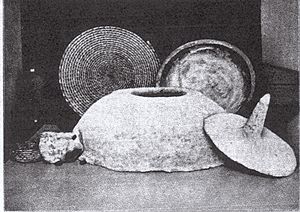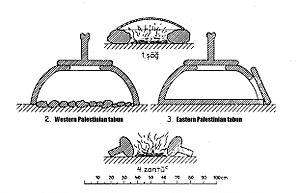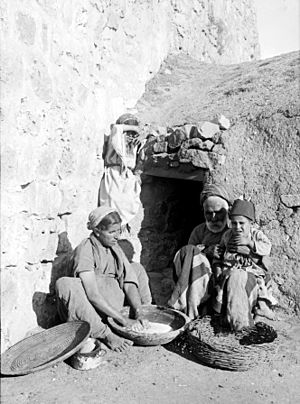Tabun oven facts for kids
A tabun oven, or simply tabun (also spelled taboon, from the Arabic: طابون), is a special clay oven. It looks like a cone with its top cut off. There is an opening at the bottom to add fire. People have used these ovens for thousands of years, even in biblical times. They were often used by families, neighborhoods, or whole villages. Tabun ovens are still built and used in parts of the Middle East today. Some modern tabun ovens are even made from metal.
Contents
How Tabun Ovens Are Used
Tabun ovens are famous for baking delicious flatbreads. Two popular types are taboon bread and laffa. People have used these ovens for hundreds of years across the Middle East.
What Fuels a Tabun?
Many different things can be used to heat a tabun oven. People often use dried animal dung or bird droppings. They also use chopped tree branches, wood chips, or charcoal. Dried leaves, fabrics, and other materials can also be used as fuel.
Heating the Oven
First, the top opening of the oven is covered. Then, a layer of fuel is spread around the outside of the oven and on its lid. Once the fire starts, the fuel is covered with a layer of ash. The fuel will slowly burn for many hours, sometimes all night long. The smoke also helps keep insects and mosquitoes away. As the fuel burns, the heat gets stored in the oven's base. The amount of fuel needed depends on the oven's size.
Baking Food
When the smoke stops, the lid is taken off. Pieces of dough are flattened by hand and placed right onto the hot stones inside the oven. Most tabun ovens can bake 4 to 5 loaves of bread at the same time. After placing the bread, the opening is sealed. The fire is kept going using the hot embers and ashes. When the bread is ready, the lid is removed, and the bread is taken out. You can repeat this process or bake other dishes using metal or pottery trays. The bottom of the bread will have the shape of the pebbles or stones used for the oven floor. This way of baking is unique and saves fuel. It also makes food that smells and tastes wonderful!
In some clay ovens, the flattened dough is placed on the inner wall of the oven. The wall is first dampened with a wet cloth so the dough sticks. After baking, the bread is removed.
How Tabun Ovens Are Built
The Oven Shell
The main part of the oven, called the shell, is made from yellow pottery clay soil. Good clay for this often comes from places like Aaroub or Al Aaroub. The soil is mixed with water to make a thick clay. Chopped stubble and straw from harvested wheat are added to the clay. The clay is then shaped by hand into a dome. The bottom of the dome is about 30 to 40 inches wide. It stands about 15 to 20 inches tall and has an open top about 15 inches wide. The walls of the shell are about 1 to 2 inches thick. The shell is left in the sun to dry for several weeks before it is heated for the first time.
The Oven Base
The base of the oven is about 4 to 5 feet wide and 15 to 20 inches deep. It is usually filled with materials that can hold and store heat well. These materials are often found nearby, like broken glass, sand, rock salt, beach stones, or Suwan stones (which are flint stones). These materials are packed down tightly.
The Oven Lid
The lid is made from clay or a piece of sheet metal. It needs to be large enough to cover the opening at the top of the oven.
Building Process
A tabun oven is usually built in a sheltered spot, like a clay hut or a cave. First, a hole is dug for the base, and it is filled and packed down with the heat-storing materials. Then, the clay shell is placed on top of the base, with its wider side down. A layer of clean, smooth limestone pebbles, about 1 inch wide, is spread inside the shell on top of the base. These pebbles create a clean surface for baking.
See also
 In Spanish: Horno tabún para niños
In Spanish: Horno tabún para niños




